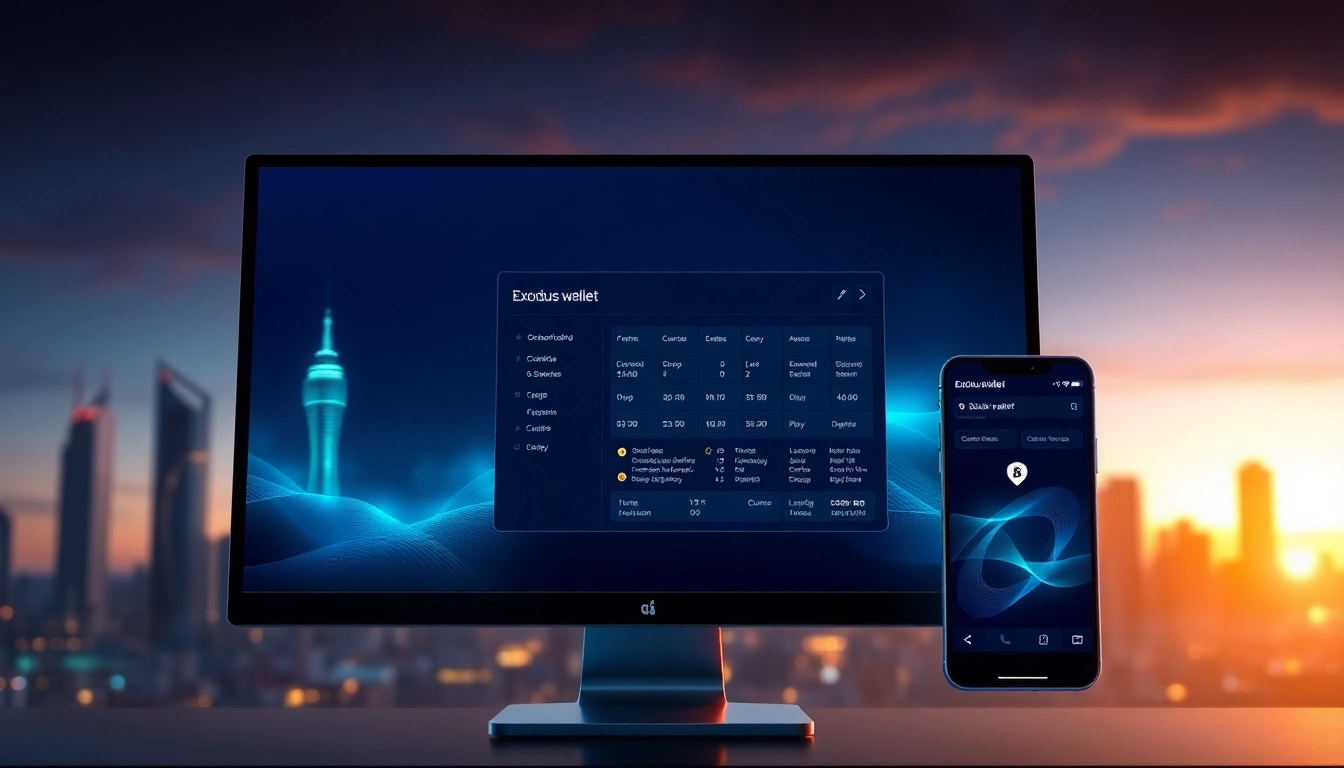1. What is the Exodus Wallet?
The exodus wallet is a popular multi-currency cryptocurrency wallet that provides users with a secure and user-friendly platform for managing their digital assets. Designed for both novice and veteran cryptocurrency enthusiasts, the Exodus Wallet supports a wide array of cryptocurrencies and offers a seamless experience when buying, exchanging, and managing these digital currencies. Its intuitive interface and strong focus on user experience set it apart in the ever-evolving cryptocurrency landscape.
1.1 Overview of Wallet Features
Exodus Wallet boasts a range of features designed to enhance the user experience while providing essential functionality for cryptocurrency management. Key features include:
- Multi-Currency Support: Exodus allows users to manage over 100 cryptocurrencies, including Bitcoin, Ethereum, Litecoin, and many altcoins. This flexibility allows users to diversify their portfolios within a single platform.
- Built-in Exchange: The wallet includes a built-in exchange feature, enabling users to trade cryptocurrencies without leaving the app. Users can easily swap one cryptocurrency for another at competitive rates.
- User-Friendly Interface: The clean and accessible design guides users through their cryptocurrency management tasks, making it an excellent choice for beginners.
- Mobile and Desktop Compatibility: Exodus is available for both mobile devices (iOS and Android) and desktop computers (Windows, Mac, and Linux), allowing users to access their wallets across multiple platforms.
- Cold Storage Options: Although primarily a hot wallet, Exodus offers functionality to secure assets in offline cold storage, enhancing security for long-term holdings.
1.2 How Exodus Wallet Works
Exodus Wallet operates as a non-custodial wallet, meaning users retain full control over their private keys and funds. When a user creates an Exodus Wallet, a unique seed phrase is generated, which can be used to restore access to the wallet. This process works seamlessly through the following steps:
- Wallet Creation: Users download the Exodus Wallet app and follow straightforward instructions to set up a new wallet, including writing down their unique recovery seed phrase.
- Receiving and Sending Assets: Users can easily receive assets by generating wallet addresses, while sending assets involves scanning a QR code or entering a wallet address.
- Exchanging Assets: The wallet’s integrated exchange allows users to trade supported cryptocurrencies directly within the app, simplifying the process without needing to use third-party exchanges.
- Market Insights: Exodus includes real-time market charts and data, allowing users to track their investments and make informed decisions about buying or selling.
1.3 Key Benefits for Users
Exodus Wallet offers several key benefits that appeal to both new and experienced cryptocurrency users:
- Control Over Funds: Users maintain control of their private keys, granting them ownership without relying on intermediaries.
- Accessibility: The wallet’s intuitive interface and multi-platform availability allow users to manage their assets conveniently anytime, anywhere.
- Great for Beginners: Its user-friendly design makes it easy for newcomers to navigate the world of cryptocurrency, while still providing advanced features for experienced users.
- Integrated Support: Exodus provides quick access to customer support resources directly within the app, ensuring users can resolve issues promptly.
- Diverse Asset Management: With support for a variety of cryptocurrencies and integrated exchange functions, users can manage multiple assets in a single location seamlessly.
2. How to Set Up Your Exodus Wallet
Setting up your Exodus Wallet is a straightforward process that ensures you have a secure platform for your cryptocurrency management. Here’s a detailed guide on how to get started:
2.1 Step-by-Step Registration Process
To register your Exodus Wallet, follow these steps:
- Download the App: Depending on your device, download the Exodus Wallet app from the official website or appropriate app store. Ensure you have the latest version to avoid security vulnerabilities.
- Create a New Wallet: Open the app and select “Create New Wallet.” The app will generate a recovery seed phrase containing 12 to 24 words.
- Backup Your Seed Phrase: Write down your recovery seed phrase and store it in a safe location. Never share this phrase with anyone, as it is the only way to recover your wallet if you lose access.
- Set a Password: Establish a strong password for your wallet. It adds an extra layer of security when accessing the app on your device.
- Explore the Interface: Familiarize yourself with the wallet’s features and dashboard to maximize your experience.
2.2 Securing Your Wallet with Best Practices
To protect your assets within the Exodus Wallet, implement the following best practices:
- Enable Strong Passwords: Always use a unique and complex password that combines letters, numbers, and special characters.
- Regular Backups: Periodically back up your seed phrase and wallet data to ensure you can recover your funds in case of device loss or malfunction.
- Two-Factor Authentication (2FA): Although Exodus doesn’t provide built-in 2FA, consider utilizing it where possible, for example, with email linked to crypto exchanges.
- Update Regularly: Keep your Exodus Wallet app updated to benefit from the latest security enhancements and features.
- Be Cautious with Public Wi-Fi: Avoid accessing your wallet over public or unsecured networks to reduce the risk of interception by hackers.
2.3 Importing Existing Wallets
If you already have a cryptocurrency wallet and wish to switch to Exodus, you can easily import your existing wallet. Here’s how to do it:
- Select “Restore Wallet”: Open the Exodus app and click on the “Restore Wallet” option.
- Enter Your Seed Phrase: Provide your 12 to 24-word seed phrase, which was generated by your original wallet. Ensure you enter them in the correct sequence.
- Set Up Security: After importing the wallet, create a new password and backup your new seed phrase as prompted.
- Verify Assets: Once restored, check your wallet dashboard to ensure all your assets appear correctly.
3. Managing Cryptocurrencies with Exodus Wallet
Managing your cryptocurrencies within Exodus Wallet is efficient and user-friendly. Here’s how to navigate and optimize your wallet experience:
3.1 Adding and Exchanging Crypto Assets
To add or exchange cryptocurrency assets in Exodus, follow these steps:
- Adding Assets: In the wallet dashboard, click on “Add More” to choose from over 1000+ supported cryptocurrencies. Each addition updates your assets within the app for easy access.
- Exchanging Assets: Use the built-in exchange feature by selecting the “Exchange” tab. Choose the cryptocurrency you want to swap from and to, input the amount, and confirm the exchange.
3.2 Tracking Market Trends and Performance
Exodus Wallet provides integrated market insights to help you make informed decisions:
- Real-Time Market Data: The wallet displays current prices, market caps, and volume data directly on the dashboard. Users can track their portfolio’s overall market performance at a glance.
- Historical Performance Charts: Access historical price charts for individual cryptocurrencies to analyze trends over time, helping you make educated investment choices.
- News and Alerts: Follow cryptocurrency news and set alert notifications for specific price thresholds or market changes to stay engaged.
3.3 Understanding Transaction Fees
When using Exodus Wallet, it is crucial to understand how transaction fees work:
- Exchange Fees: The wallet charges built-in fees for exchanging cryptocurrencies. These fees may vary, so it’s advisable to check before making trades.
- Network Fees: When sending or receiving funds, users incur network fees determined by the blockchain’s current activity. Fees may fluctuate depending on demand and supply.
- Transparency: Exodus provides clear information about fees at the time of transactions, allowing users to confirm and understand costs before proceeding.
4. Security Features of Exodus Wallet
Ensuring the security of your digital assets is paramount when using the Exodus Wallet. The wallet offers several security measures:
4.1 Cold Storage Implementations
Exodus Wallet primarily acts as a hot wallet, but it supports cold storage functionalities—especially when users opt to transfer significant holdings to hardware wallets. Here’s how to take advantage of this feature:
- Hardware Wallet Integration: Exodus allows integration with hardware wallets like Trezor, providing a secure offline storage solution for large amounts of cryptocurrency.
- Secure Asset Transfer: Users can transfer assets from their Exodus Wallet to any hardware wallet, ensuring that their private keys are kept offline, reducing the risk of hacking.
4.2 Protecting Against Hacks and Phishing
Phishing attacks are common in the crypto space, and Exodus provides tools and guidance to help mitigate these risks:
- Phishing Awareness: The wallet promotes awareness among users about common phishing schemes and tactics to remain vigilant, such as checking URLs and avoiding suspicious links.
- Secure Access: The app restricts unauthorized access with password protection and, when applicable, biometric features on mobile devices for better security.
4.3 Best Practices for User Safety
For optimal safety while using Exodus Wallet, consider implementing these best practices:
- Regularly Update Software: Ensure that your device’s operating system and the Exodus Wallet app are up to date to protect against vulnerabilities.
- Educate Yourself: Stay informed about cryptocurrency security and potential threats to better protect your investments.
- Use Unique Passwords: For enhanced security, use different passwords for different accounts and wallets, reducing the risk of multiple accounts being compromised at once.
5. Future of Exodus Wallet and Crypto Management
The cryptocurrency landscape is constantly evolving, and so is the Exodus Wallet. Understanding its future direction can help users make informed decisions:
5.1 Upcoming Features and Enhancements
Exodus is continuously working on enhancing its platform with exciting new features:
- Expanded Asset Support: The wallet plans to integrate support for additional cryptocurrencies and tokens, ensuring that users can manage all their digital assets within one platform.
- Improved User Experience: Developers are focused on enhancing the interface to simplify navigation and improve interaction, especially for beginners.
- Decentralized Finance (DeFi) Integrations: Exodus is looking into implementing DeFi services, enabling users to earn interest on their crypto holdings and make the most of their digital assets.
5.2 Impact of Market Changes on Wallet Usability
The evolving cryptocurrency market can significantly impact how the Exodus Wallet functions:
- Market Volatility: High market volatility can influence user behavior, leading to changes in trading and management needs. Exodus may adapt features to facilitate rapid transactions.
- Regulatory Adjustments: Ongoing regulations in the crypto space can affect how wallets operate, pushing Exodus to ensure compliance and user protection.
5.3 Community Engagement and Support
The Exodus Wallet community plays an important role in its development:
- User Feedback: Exodus actively seeks feedback from its user base to improve services and features, encouraging engagement and participation in its roadmap.
- Educational Resources: The wallet provides a wealth of resources, including tutorials, articles, and customer support, to assist users in navigating their crypto journey effectively.






